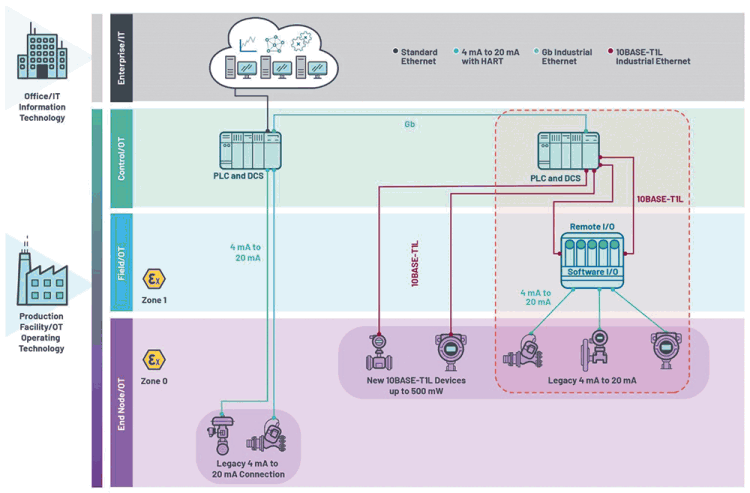
Traditionally, field instruments are connected to the Ethernet domain using legacy analog signalling
A software configurable I/O system provides a seamless transition from legacy analog signalling to the Industrial Ethernet domain. Software configurable I/O devices can provide any function (analog I/O, digital I/O, RTD) on any channel through remote configuration, which helps ease commissioning. This flexibility, combined with diagnostics capability, allows for remote troubleshooting, thus saving time for technicians. Figure 1 shows the evolution of industrial connectivity from legacy analog signalling to smart, digitally connected sensors with software-configurable I/O enabling a seamless transition.
Analog Devices’ AD74413R software-configurable I/O coupled with the ADP1032 two-channel isolated micropower management unit (µPMU) is one example of a robust software-configurable I/O solution. The AD74413R is a quad-channel software-configurable I/O that is equipped with automatic fault detection and diagnostic capabilities. The ADP1032 is tailored to the AD74413R to provide isolated power and data channels, which allow for a compact and isolated software-configurable I/O system.

Channel flexibility
For industrial applications with varying I/O requirements, system designers need a flexible system that can be quickly configured to adapt to the required demand. The four channels of the AD74413R can be configured into various input and output modes such as:
• High impedance.
• Voltage input.
• Voltage output.
• Externally powered current input.
• Loop-powered current input.
• Current output.
• Digital input logic.
• Loop-powered digital input.
• RTD measurement.
A single set of external discrete components is required to support any function on any of the four channels, offering full flexibility. If an actuator or sensor is not wired correctly, the channel can be reconfigured with a single SPI.
Having all functions available in a single package requires fewer components in the hardware design, which leads to lower assembly and test costs, higher reliability and easier debugging, simplified procurement, and higher channel density compared to discrete implementations of universal I/O.
Fault detection and diagnostic capabilities
The AD74413R is equipped with automatic fault detection and different diagnostic functions to help with fault isolation. Users can interrogate an alert register to determine the exact cause of a reported fault. Users can also enable diagnostic signals to further diagnose the identified fault.
These capabilities allow technicians to remotely troubleshoot any faults occurring in the system. In many existing systems, sensors and actuators may be located far away from the control room and in potentially hazardous areas. In addition, crowded cabling may also make it difficult to determine which cables are connected to which sensor or actuator, making it cost prohibitive and time-consuming to physically rewire these systems. The AD74413R modules provide configurability and diagnostics to determine which sensor or actuator is connected to a particular channel.
Isolated power and data solution
The ADP1032 satisfies the requirement for isolated power and data channels by having two isolated and regulated rails and seven data isolation channels all in one package. This provides a board area reduction up to three times compared to a discrete power and data isolation solution. This allows customers to increase the overall channel density in their modules. The four SPI signals of the AD74413R use the high-speed isolated data channels of the ADP1032, which are optimised for low propagation delays of 15 ns, supporting SPI clock rates up to 16,6 MHz. The low-speed isolated data channels are used where timing is not critical.
Power dissipation
Having a flexible multi-channel system poses a trade-off on the system power dissipation because each channel of the AD74413R software-configurable I/O can be configured to various modes while the power supply for the AD74413R sticks to a single output voltage. The designer must pick the highest AD74413R AVDD supply voltage so that the worst-case condition can be supported with consideration to the load characteristics, to ensure the proper operation of each mode.
Conclusion
The digitalisation of factories brings increased production output, factory utilisation, and labour productivity. However, the transition to the digital factory is a challenge because legacy systems lack 10BASE-T1L-supported sensors and actuators. The AD74413R software-configurable I/O, coupled with the ADP1032, bridges the gap for Ethernet-enabled field instruments. The four channels of the AD74413R are flexible and can each be programmed to eight different I/O configurations. Its fault detection and diagnostic capabilities save time during the debugging and commissioning of a system. The diagnostic capability can also be used to monitor systems for maintenance. Finally, the ADP1032 galvanically isolates the data and power sources, ensuring the safe and efficient transfer of power and data.
| Tel: | +27 11 923 9600 |
| Email: | [email protected] |
| www: | www.altronarrow.com |
| Articles: | More information and articles about Altron Arrow |

© Technews Publishing (Pty) Ltd | All Rights Reserved